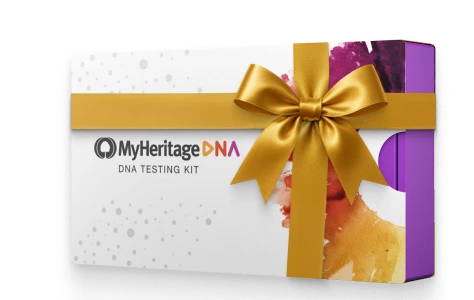
Social media can be extremely useful and beneficial for genealogical research because it allows individuals to connect with others who may have information or documents related to their family history. Those might be people one doesn’t even know about. Additionally, social media platforms can provide access to online communities and resources dedicated to genealogy and family history.
Social media encompasses all internet applications that prioritize communication, interaction, content sharing, and collaboration. It can be used for personal reasons, like sharing family photos or connecting with communities, as well as for promoting businesses and services.
Research your ancestors on MyHeritage
Social media platformsSocial media platforms
When it comes to social media, the internet is full of options. However, for genealogy research, it's important to focus on platforms that provide access to information and a large user base. While trends may change over time, currently Facebook, Instagram, Twitter, and LinkedIn remain the main contenders in 2023. Platforms might be labeled as "for the older generation" (such as Facebook) or "for the younger generation" (such as Instagram), but these trends are constantly changing. To effectively use each platform for genealogy research, it's essential to understand their framework, type, and rules.
FacebookFacebook
In 2004, Mark Zuckerberg founded Facebook as a means for Harvard University students to connect. Today, over 1 billion users worldwide utilize the platform, and anyone over the age of 13 can create a Facebook page and access it through their PC or mobile device. With features like personal and business pages, as well as groups, Facebook has become a staple for online communication. If you are interested in genealogy, groups could be particularly useful to you.
Understanding the Different Types of GroupsUnderstanding the Different Types of Groups
Groups can be divided into three categories based on their privacy settings:
- Open groups: These are public groups, meaning anyone can find them, view their members, and read their posts.
- Closed groups: Anyone can find these groups, but only members can view posts and engage with the group.
- Secret groups: Only members can view any information shared in the group. Non-members cannot find the group through search.
For genealogy purposes, we will focus on the first two types of groups.
It's essential to have a clear idea of what you're looking for before searching for groups on Facebook. Determine your objectives and list them all to stay organized and focused.
When searching for interest groups, there are several options to consider. Here are just a few examples:
- Surnames
- Place: neighborhood, school, university
- Event: immigration by a certain ship, harbor
- Membership: a society, church, or sports club
- Geographical: state, town or village.
- Historical events: Holocaust, WWI, WWII, the American Revolution
- Ethnicity: Irish, Jewish, African American, Native American, and many more.
- Interest: genealogy (both in general and specific regions), DNA (each DNA company has several pages and user groups), history, and more.
By exploring these options, you can find the perfect group to suit your needs.
Use the search box (located top left)

When searching for a particular topic, take advantage of Facebook's suggested groups feature. These groups can be incredibly useful for sharing information and posting questions, and photos. You never know, someone in the group might recognize the people in your family photos that you're unsure about.
When joining a group, it's important to familiarize yourself with the community culture and guidelines. Before posting anything, be sure to follow these two steps:
- Read the rules closely to understand what types of questions are appropriate to ask, and what information group members are able to share.
- Explore the media and files section, as you may find the information or images you're seeking already there.
Consider Facebook as the FAN club (friends, associates, and neighbors) - through posting on Facebook, we can reach those in the FAN club. By posting photos of unknown people and asking the people in the group whether they can identify anyone. By searching photos, you can identify people in photos that are not yours.
Facebook and DNA matchesFacebook and DNA matches
To learn more about your DNA match, try searching for their name or nickname on Facebook. Once you've located their profile, click on the "About" button to see details about their background, current location, contact information and other family members they may be connected to. Remember that every user can choose what information to share. You may find very little or a lot, depending on their preferences.

Click the "Photos" button and search for images that appear aged. Once you've found some images, pay attention to their descriptions and comments. Doing so may reveal information about the individuals in the photos, including their relationships or connections. With this information, you may be able to build a small family tree.
Facebook's algorithms are designed to learn about your interests. The more you search for a specific subject or name, the more it will suggest related content and pages.
InstagramInstagram

Instagram, or Insta, is a social platform created in 2010 by Kevin Systrom and Mike Krieger for iOS users. It was created with the initial goal of promoting communication through images. Two years later, in 2012, Android users also gained access to the app. The same year, Instagram was acquired by Facebook.
While primarily a photo-sharing platform, Instagram has evolved over the years to include videos and various features beyond the original feed, these include:
- Stories, which last for 24 hours
- Reels, which are mostly videos and can be up to 90 seconds long
It is also possible to use Instagram on your PC, although the editing features are limited compared to the mobile app.
Take some time to consider the benefits of each feature and determine whether it can offer the solutions you're looking for. Instagram provides the option to follow prominent experts for insights on new research techniques or to join an interest group tailored to your preferences. Begin exploring by utilizing the search icon (magnifying glass). Moreover, you can use Instagram to foster connections with younger family members, involving them in the process of researching and documenting family history.
Here are some useful tips to help you find information on Instagram:
- Use relevant hashtags such as #genealogy, #familyhistory, and #ancestry to locate posts related to your research
- Follow museums, archives, and libraries accounts that may have resources relevant to your research
- Share photos of your ancestors and family history-related content to potentially connect with distant relatives and gain new information.
Twitter/XTwitter/X
Twitter, launched in 2006 and rebranded as X in 2023, is a highly popular social networking site that allows you to share text, images, and videos. Unless you're a paid subscriber, your texts should be no longer than 280 characters.
Twitter is a great platform to follow genealogy experts, organizations, and societies. You can also use the search function to find specific surnames or locations. By tweeting about your research and findings, you can connect with other researchers from around the world.
LinkedInLinkedIn
Think outside the boxThink outside the box
Combining research and platforms to obtain Information
When conducting research, it's important to think outside the box and consider using multiple platforms.
Here's an example of how you can do this:
- Let's say you have a DNA match, but only a nickname or a name to work with.
- Look up the person on Facebook and see what information you can gather. If necessary, leave a message.
- If you notice the person hasn't been active on Facebook for a while, try to find out their line of work.
- Once you've discovered their workplace, search for the company on LinkedIn. This may provide you with more information, as well as a greater chance of making a connection.
Maximizing the benefits of social media for genealogy researchMaximizing the benefits of social media for genealogy research

Take the time to understand how each platform works. Once you are familiar with the platforms, consider your research question or what kind of information you are seeking. This will help you determine the best platform to use, ensuring that you find what you are looking for. Keep in mind that utilizing social media platforms for genealogy research is a time-consuming process. It may take some time to see results since they depend on the engagement of others with what you post.
Guidelines for all social media platformsGuidelines for all social media platforms
Follow these tips to ensure a positive and safe experience for everyone:
- Before engaging, read and understand all privacy policies, terms and conditions.
- Be patient and respectful of others' time.
- Fact-check any information found on social media before sharing.
- Verify information before posting to avoid spreading misinformation.
- Engage with others to increase exposure to your content.
- Be mindful of what you share as it may be difficult to remove later.
- Include important details about people in your photos, such as names and relevant information.
- Be open to connecting with potential relatives who may come across your posts.
- Be kind and respectful to other users.
- Take breaks from social media to prevent burnout.
Remember, social media should be a positive and enjoyable experience for everyone.
Explore more about using social media for genealogy researchExplore more about using social media for genealogy research
- Crowdsourcing with Social Media to Overcome Brick Walls in Genealogy Research, webinar by Amie Bowser Tennant on Legacy Family Tree Webinars
- Top 10 Tips for Genealogists on Social Media, webinar by Marie Cappart on Legacy Family Tree Webinars
- Staying Safe with Social Media, webinar by Thomas MacEntee on Legacy Family Tree Webinars
- MyHeritage on Facebook
- MyHeritage on Instagram
- MyHeritage on Twitter/X


